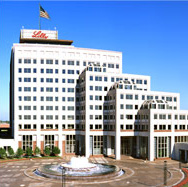 |
| Eli Lilly's Indianapolis, IN, headquarters--Courtesy of Eli Lilly |
More than 6 years after a stunning burglary in which thieves rappelled into an Eli Lilly ($LLY) warehouse, disabled alarms and drove away with $70 million in drugs, the event reverberates through the pharma industry. How did they do it? A trial starting this week in Miami points the finger at a security firm, raising questions how drugmakers can best protect their supply chains.
The lawsuit was filed by Lilly's insurer, National Union of Pittsburgh, which is trying to recover from security firm ADT/Tyco about $42 million. The lawsuit claims the gang, led by brothers Amaury and Amed Villa, gained access to the company's assessment of the warehouse that showed all of its weak points.
With that info, the lawsuit says the Villas were able to rappel through the one spot in the warehouse roof that was unprotected. They were able to break into a control room "undetected by monitoring equipment and disabled the existing security system's master controls, telecommunications systems and cell batteries to the back-up communications systems."
The Villa brothers, who have pleaded guilty to charges related to the burglary, were among 23 suspects arrested for a series of cargo thefts, tracked through DNA evidence left at one of the scenes. While it is not known how they might have got the info, the complaint says there were other burglaries that exploited vulnerabilities at sites where security services had been provided by ADT/Tyco.
"Either they were given access to this data, or there was a weak link that allowed ADT to be hacked," Elisa Gilbert, a lawyer for insurer has said. "Anyone who got hold of that document would have had a road map to get in."
After the Lilly heist and other break-ins, the pharma industry upped its efforts to fight cargo theft, with organizations like the Pharmaceutical Cargo Security Coalition leading the way. In 2010 when the Lilly caper occurred, the average loss was $3.7 million per incident. In Q3 last year, the average loss was $558,000, according to the FreightWatch International.
- read the release